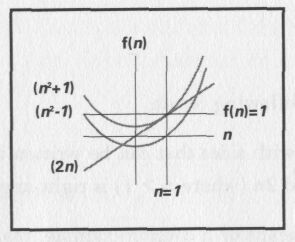"The Curious Incident of the Dog in the Night-Time" - читать интересную книгу автора (Haddon Mark)
Appendix
Question
Prove the following result:
A triangle with sides that can be written in the form n^2 + 1, n^2 – 1 and 2n (where n gt; 1) is right-angled.
Show, by means of a counterexample, that the converse is false.
Answer
First we must determine which is the longest side of a triangle with sides that can be written in the form n^2 + 1, n^2 – 1 and 2n (where n gt; 1)
n^2 + 1 – 2n = (n – 1)^2
and if n gt; 1 then (n – 1)^2 gt; 0
therefore n^2 + 1 – 2n gt; 0
therefore n^2 + 1 gt; 2n
Similarly (n^2 + 1) – (n^2 – 1) = 2
therefore n^2 + 1 gt; n^2 – 1
This means that n^2 + 1 is the longest side of a triangle with sides that can be written in the form n^2 + 1, n^2 – 1 and 2n (where n gt; 1).
This can also be shown by means of the following graph (but this doesn’t prove anything):
 |
According to Pythagoras’s theorem, if the sum of the squares of the two shorter sides equals the square of the hypotenuse, then the triangle is right-angled. Therefore to prove that the triangle is right-angled we need to show that this is the case.
The sum of the squares of the shorter two sides is (n^2 – 1)^2 + (2n)^2
(n^2 – 1)^2 + (2n)^2 = n^4 – 2n^2 + 1 + 4n^2 = n^4 + 2n^2 + 1
The square of the hypotenuse is (n^2 + 1)^2
(n^2 + 1)^2 = n^4 + 2n^2 + 1
Therefore the sum of the squares of the shorter two sides is equal to the square of the hypotenuse and the triangle is right-angled.
And the converse of “A triangle with sides that can be written in the form n^2 + 1, n^2 – 1 and 2n (where n gt; 1) is right-angled” is “A triangle that is right-angled has sides whose lengths can be written in the form n^2 + 1, n^2 – 1 and 2n (where n gt; 1).”
And a counterexample means finding a triangle which is right-angled but whose sides cannot be written in the form n^2 + 1, n^2 – 1 and 2n (where n gt; 1).
So let the hypotenuse of the right-angled triangle ABC be AB.
and let AB = 65
and let BC = 60
Then CA = v (AB2 – BC2) = v (652 – 602) = v (4225 – 3600) = v 625 = 25
Let AB = n^2 + 1 = 65
then n = v (65 – 1) = v 64 = 8
therefore (n^2 – 1) = 64 – 1 = 63 ? BC = 60 ? CA = 25
and 2n = 16 ? BC = 60 ? CA = 25
Therefore the triangle ABC is right-angled but it does not have sides which can be written in the form n^2 + 1, n^2 – 1 and 2n (where n gt; 1).
(support [a t] reallib.org)